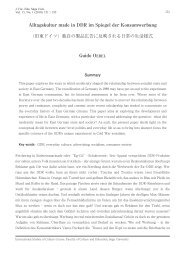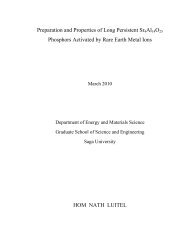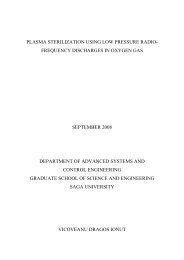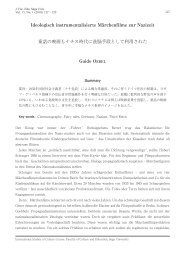High Order Harmonic Oscillators in Microwave and Millimeter-wave ...
High Order Harmonic Oscillators in Microwave and Millimeter-wave ...
High Order Harmonic Oscillators in Microwave and Millimeter-wave ...
- No tags were found...
Create successful ePaper yourself
Turn your PDF publications into a flip-book with our unique Google optimized e-Paper software.
2 <strong>Oscillators</strong><br />
Recall from circuit analysis that if the ith node of the circuit is grounded, so that V i = 0,<br />
the matrix of (2.3) will be modified by elim<strong>in</strong>at<strong>in</strong>g the ith row <strong>and</strong> column, reduc<strong>in</strong>g the<br />
modified by add<strong>in</strong>g the correspond<strong>in</strong>g rows <strong>and</strong> columns.<br />
2.2.1 <strong>Oscillators</strong> Us<strong>in</strong>g a FET<br />
Next consider an oscillator us<strong>in</strong>g an FET <strong>in</strong> a common gate configuration. In this case<br />
V 1 = 0, <strong>and</strong> aga<strong>in</strong> V 3 = V 4 provides the feedback path. For an FET the <strong>in</strong>put admittance<br />
can be neglected, so we set G i = 0. Then the matrix of (2.3) reduces to<br />
[<br />
(Y1 + Y 2 + g m + G 0 ) −(Y 2 + G 0 )<br />
−(G 0 + g m + Y 2 ) (Y 2 + Y 3 + G 0 )<br />
] [<br />
V2<br />
V<br />
]<br />
= 0, (2.4)<br />
where V = V 3 = V 4 . Aga<strong>in</strong> we assume the feedback network is composed of loss less<br />
reactive elements, so that Y 1 ,Y 2 <strong>and</strong> Y 3 can be replaced with their susceptances. Sett<strong>in</strong>g<br />
the determ<strong>in</strong>ant of (2.4) to zero then gives<br />
∣<br />
(g m + G 0 ) + j(B 1 + B 2 ) −G 0 − jB 2<br />
−(G 0 + g m ) − jB 2 G 0 + j(B 2 + B 3 )<br />
= 0. (2.5)<br />
∣<br />
Equat<strong>in</strong>g the real <strong>and</strong> imag<strong>in</strong>ary parts to zero gives two equations:<br />
1<br />
+ 1 + 1 B 1 B 2 B 3<br />
= 0, (2.6)<br />
G 0<br />
+ g m<br />
+ G 0<br />
B 3 B 1 B 1<br />
= 0. (2.7)<br />
As before, let X 1 ,X 2 , <strong>and</strong> X 3 be the reciprocals of the correspond<strong>in</strong>g susceptances. Then<br />
(2.6) can be rewritten as<br />
X 1 + X 2 + X 3 = 0. (2.8)<br />
Us<strong>in</strong>g (2.6) to elim<strong>in</strong>ate B 3 from (2.7) reduces that equation to<br />
X 2<br />
X 1<br />
= g m<br />
G 0<br />
. (2.9)<br />
S<strong>in</strong>ce g m <strong>and</strong> G 0 are positive, (2.9) shows that X 1 <strong>and</strong> X 2 must have the same sign,<br />
while (2.8) <strong>in</strong>dicates that X 3 must have the opposite sign. If X 1 <strong>and</strong> X 2 are chosen to be<br />
negative, then these elements will be capacitive <strong>and</strong> X 3 will be <strong>in</strong>ductive. This conclusion<br />
11







